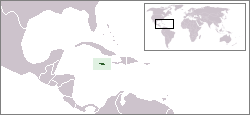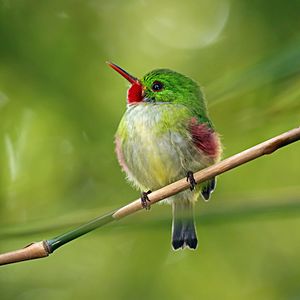Jamaican tody facts for kids
Quick facts for kids Jamaican tody |
|
|---|---|
 |
|
| Photo of Jamaican tody (Todus todus) taken by Dominic Sherony | |
| Conservation status | |
| Scientific classification | |
| Genus: |
Todus
|
| Species: |
todus
|
 |
|
| Green color shows range of species Todus todus - only found in Jamaica | |
| Synonyms | |
|
|
The Jamaican tody (Todus todus) is a small, colorful bird found only on the island of Jamaica. People in Jamaica sometimes call it the rasta bird, robin, or robin redbreast. It belongs to a group of birds called Todus, which are known for their bright colors and unique habits.
Contents
Discovering the Jamaican Tody
The Jamaican tody was first officially described in 1758 by a Swedish scientist named Carl Linnaeus. He was famous for creating the system we use today to name living things. Linnaeus first thought this bird was a type of kingfisher and gave it the scientific name Alcedo todus. Later, in 1760, a French zoologist named Mathurin Jacques Brisson created the genus Todus, and the Jamaican tody was placed there.
What Does the Jamaican Tody Look Like?
The Jamaican tody is a tiny, plump bird, usually about 9 cm (or 4.25 inches) long. It weighs around 6.4 grams, which is about the same as two pennies! Its wings are about 46mm long.
This bird has a bright green head and back, with a striking red throat. Its bill is long, wide, and flat, also red in color. Its chest is whitish, blending into a slightly yellow belly and under the tail. You might notice blue-gray feathers near its ears. Its legs and feet are reddish-brown.
It looks a lot like the Puerto Rican tody, but the Jamaican tody has a whiter chest. Both male and female Jamaican todies look very similar, even their eye color is hard to tell apart.
During spring and summer, these birds can be quite noisy! They make a loud "beep" sound, which is a bit like a nasal note. They also make a fast, harsh "throat-rattle" noise, especially when they are protecting their territory.
Where Do Jamaican Todies Live?
The Jamaican tody lives only in Jamaica. You can find them all over the island, from the dry coastal areas to the humid mountains. They usually travel in pairs.
These birds prefer living in forests, including:
- Forests that are growing back after being cut down.
- Untouched natural forests.
- Forests on limestone hills.
- Shady coffee farms.
- Even mangroves (trees that grow in salty water).
They are easiest to spot and hear during the spring and summer months. In fall and winter, they become much quieter and harder to find.
How Do Jamaican Todies Behave?
Keeping Clean
Jamaican todies have special ways to keep themselves clean. They sometimes bathe by diving into water while flying. They also enjoy bathing in wet plant leaves or during light rain.
After eating or cleaning their feathers, they often wipe their beaks. They clean both sides of their flat bill, from the base to the tip. To fluff up their head feathers, they shake their head quickly. They also use their flat bills to smooth their chest and wing feathers.
Reproduction and Life Cycle
During the breeding season, which lasts from December to July, Jamaican todies become more active and noisy. They rattle their wings to attract a mate and to show other birds that an area is their territory. Sometimes, a male will even offer a dead insect to a female as part of courtship!
These birds dig their nests in the soil, often on top of hard limestone. They use their strong beaks to create a burrow, which is like a tunnel. At the end of the burrow, they create an unlined chamber where they lay their eggs.
Their eggs are round, shiny, and white. When first laid, they might have a pinkish tint. A female usually lays one egg each night until she has a clutch of 1 to 4 eggs. The eggs are incubated (kept warm) for about 21 to 22 days before they hatch. Once the chicks hatch, the empty eggshells are left in the nest.
Sometimes, other animals like spiders, field mice, or lizards might try to live in the todies' burrows!
What Do Jamaican Todies Eat?
The Jamaican tody mainly eats insects and their larvae (young forms), but they will sometimes eat fruit too. They are very good at finding food. They use a "sit-and-watch" method: they perch on a branch and look for insects on the underside (or sometimes top) of leaves.
Once they spot an insect, they quickly swoop down or up to catch it. Smaller insects are swallowed while flying. Larger insects are first smashed against a twig before the tody eats them. They eat almost constantly throughout the day, catching about 1 to 2 insects every minute if there are enough available. It's thought they get most of their water from dew on leaves and the food they eat.
What Threats Do They Face?
One big problem for the Jamaican tody is forest fragmentation. This means that large forests are being broken up into smaller pieces, often by human activities. When todies were moved short distances in a study, many didn't return to their homes. Protecting and replanting trees in deforested areas helps these birds move around normally.
Loud noises, like cars, can also scare Jamaican todies. They might react by showing territorial behavior, like:
- Quickly flicking their wings.
- Expanding the feathers on their sides.
- Staring intensely at an opponent.
- Making loud throat-rattles and beeps.
The biggest natural threat to young todies is the Small Indian mongoose. This animal, which was brought to Jamaica by humans, often destroys tody burrows where baby birds are still growing.
How Do They Help Humans?
Humans are changing many bird habitats in Jamaica for homes and farms. Coffee farming is a big business in Jamaica. On coffee farms in the Blue Mountains, birds like the Jamaican tody play an important role.
They help control pests, especially the coffee berry borer, an insect that spends its whole life inside coffee berries. The Jamaican tody is one of the top five birds that help keep these pests under control. This means farmers have more good coffee beans to sell, which helps them earn more money!
Conservation Status
The Jamaican tody is currently listed as a species of "least concern" by the IUCN Red List of Threatened Species. This means that even though they live in a small area, their population is stable and not decreasing quickly.




